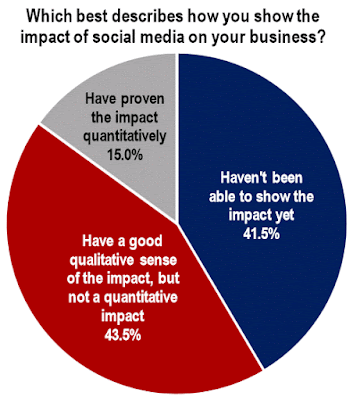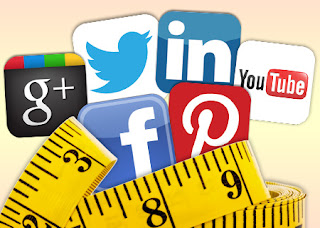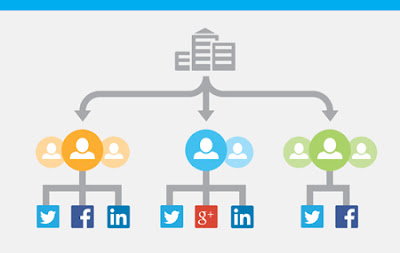Social media use isn’t quite universal—but it’s getting close. 70% of the U.S. population now has at least one social networking profile; more than half use two or more social networks. The number of worldwide social media users is projected to grow from 2.1 billion last year to 2.5 billion by 2018.

And that usage isn’t all selfies and cat videos; both consumer and B2B purchases are influenced by social content. Social media now plays almost as large a role in purchasing decisions as does TV, and 57% of consumers say they’re influenced to think more highly of business after seeing positive comments or praise online.
Still, interesting contradictions remain. Most businesses now use social media for marketing and those efforts are expected to continue to increase, yet many marketers and top executives alike find the business value difficult to quantify.
Here are four key takeaways (among the many possible) from the compilation of social media marketing facts and statistics below:
Social is important today, but even more so tomorrow. 90% of young adults—ages 18 to 29—use social media (compared to just 35% of those over age 65). Fully a third of millennials say social media is one of their preferred channels for communicating with businesses.
And those media consumption habits are unlikely to change over time, meaning that when the millennials start turning 40, their media usage will look much more like that of today’s millennials than of today’s 40-year-olds.
ROI is still tough to measure. 46% of B2B marketers say they’re not sure whether any social channels have generated revenue for their businesses. Only 13% believe they’ve proved the impact quantitatively—though that may be because just 14% tie social media marketing activities to sales levels.
For all the bashing of “vanity metrics” in social marketing, those likes and shares (“engagement”) remain the most commonly used measure for evaluating social media success. 80% of marketers use these as primary success metric; 56% base social success on website traffic.
Top executives: social media marketing is for thee, but not for me. 84% of CEOs and VPs say they use social media to help make purchasing decisions. All 100 of the top global brands maintain at least one company YouTube channel, and more than half (27 of 50) of CEOs in top global companies have appeared in a company video.
And yet—only 27% of top companies said their C-level executives were actively engaged in social media last year, down 20% from the peak in 2012. Among the top 100 global brands, just 31 CMOs maintain active Twitter accounts, and only six of those big-brand CMOs have more than 10,000 Twitter followers.
But social media marketing spending will rise anyway. Despite the lack of metrics or executive involvement, the share of overall marketing budgets devoted to social media marketing is expected to increase from about 10% on average today to nearly 25% within the next five years.
That may be because social media isn’t just about lead gen. Social is viewed as the second-most effective digital tactic for customer retention, behind only email. 64% of sales reps say they closed at least one deal in 2014 directly from social media use. And of small business owners who use social media, 92% agree that “social media marketing is important for my business.”
Read more about those findings and more in the almost four dozen superb social media stats and facts below.

10 Stats About Social Media Demographics
3. Of the 7.2 billion people on earth, 3 billion have Internet access; 2.1 billion are active on social media; and 1.7 billion use social networks from a mobile device. (Link Humans)
4. The number of worldwide social media users is expected to reach 2.5 billion by 2018. (Statistica)
7. 90% of young adults (ages 18 to 29) use social media. 35% of those over age 65 do. (Pew Research Center)
8. Every minute, Reddit users cast more than 18,000 votes; Vine users play more than one million videos; and and Snapchat users share nearly 285,000 snaps. (DR4WARD)
9. The “most important” social networks to teens and young adults (aged 12-24) are now Instagram (32%), Twitter (24%), Facebook (14%), Snapchat (13%) and Tumblr (4%). (Mary Meeker’s Internet Trends)
10. But Snapchat isn’t the best place for marketers (at least not yet). “Philosophically, it is important that Snapchat is a platform built for people and not for brands,” Snapchat’s CEO, Evan Spiegel, has stated. (V3B Blog)

9 Stats About Social Media Metrics and Measurement
11. Asked how effectively they believe social media is linked to their firm’s marketing strategy, 59.5% of CMOs were neutral or negative, while just 40.5% believed it is linked very or somewhat effectively. 45% said they haven’t been able to show social media’s impact on their companies’ performance at all. A mere 13.2% believe they have proved the impact quantitatively. (MediaPost)
12. 46% of B2B marketers are not sure whether any social channels have generated revenue for their business. (MarketingProfs)
13. However, consumers say that social media plays almost as big a role in purchasing decisions as does television. (Ad Age)
14. 60% of marketers identify “measuring ROI” as one of their top three social media marketing challenges. These are followed by closely related challenges “tying social activities to business outcomes” (50%) and “devloping our social media strategy” (48%). (Simply Measured)
15. Website traffic and “vanity metrics” (friends, followers, “likes”) are the most common metrics marketers use to measure the business impact of social media. Just 14% tie social media to sales levels. (The CMO Survey)
16. “Engagement” (such as likes, shares, etc.) is considered the most important metric for evaluating social media marketing success, with 80% of marketers identifying it as one of the top three metrics. Audience size (61%) and website traffic (56%) round out the top three. (Simply Measured)
17. Businesses of all sizes use engagement and audience size as key social media success metrics. But SMBs are more likely than enterprises to put a priority on website traffic and leads, while enterprises value customer satisfaction and competitive benchmarking more highly. (Simply Measured)
18. The tools most commonly used to measure social media marketing results are the native analytics provided by the social networks (Facebook, Twitter, etc.) themselves, at 65%. These are followed by social media management platforms like HootSuite (62%) and web analytics (e.g., Google Analytics) at 59%. Just 22% of businesses use dedicated social media measurement platforms. (Simply Measured)
19. Then again—a recent survey found 46% of CFOs admitted to making important decisions based only on instinct. (CMS Wire)

21 Social Media Marketing and Advertising Stats and Facts
20. The share of marketing budgets spent on social media is expected to more than double over the next five years, from 11% today to 24% by 2020. (The CMO Survey)
21. Another survey predicted the share of overall digital marketing budgets devoted to social media marketing will increase from 9.9% today to 22.5% within five years. (Dazeinfo)
24. Developing a social media strategy is a more common challenge among small businesses (55%) than enterprises (34%), while securing enough internal resources is a more common problem in larger companies (47%) than in SMBs (33%). (Simply Measured)
25. 33% of millennials identify social media as one of their preferred channels for communicating with businesses. Less then 5% of those 55 and older agree. (MarketingSherpa)
26. 74% of salespeople who beat their 2014 quota by 10% or more say they have an excellent understanding about the use of social media for prospecting, nurturing relationships and closing deals. They were over 6x as likely to exceed their quota than sales peers with rudimentary or no social media skills. (Forbes)
27. 64% of sales professionals reported closing at least one deal in 2014 as a direct result of using social media. (Forbes)
28. More than half (52%) of marketers say Facebook is “the most important social network they use to grow and market their business.” LinkedIn came in second place with 21%, followed by Twitter, YouTube and Google Plus. (V3B Blog)
29. 96% of small business owners/marketers use social media marketing, and 92% of those agree or strongly agree with the phrase, “Social media marketing is important for my business.” (Social Media Examiner)
30. The top three goals for SMB social media marketing programs are brand awareness (74%), website traffic (53%), and lead generaiton (41%). (Simply Measured)
32. 43% of digital marketers say social media is one of their most effective tactics, but 49% call it one of the most difficult. (TNW News)
33. Social media is viewed as the second-most effective digital marketing tactic for customer retention purposes, behind only email. (TNW News)
34. The three characteristics of brand social media posting most important to consumers, in order, are 1) the brand shares new content; 2) the content is relevant to the brand; and 3) the brand engages with its followers. (SocialTimes)
35. 57% of consumers say they’d be somewhat or very influenced to think more highly of a business after seeing positive comments or praise online, and 16% say they only share positive reviews on social media. (Direct Marketing)
36. And yet–34% of small businesses have no social media presence at all, and 36% of those who do never respond to customer comments online. (Direct Marketing)
37. For 2016, Instagram is the top social channel marketers plan to invest more advertising in (72%), followed by Facebook (61%), Pinterest (41%), Snapchat (36%) and Amazon (34%). (MediaPost)
38. Tumblr has 230 million active monthly users worldwide, and is adding 120,000 new users each day. (Infini Datum)
39. And yet–Tumblr remains one of the least exploited social networks by marketers and also advertisers, of which there are currently only 150(!) as of December 2015. (Our Social Times)
40. The top two uses of Twitter and Facebook by journalists are marketing and promotion of their stories and relationship building. 78% use Twitter for marketing; 74% use Facebook. 62% use Twitter to build relationships. (MediaPost)

7 Stats About Enterprise and Executive Social Media Use
41. Among the top 100 global brands (primarily B2C), YouTube is the most widely adopted social network; all 100 companies maintain at least one YouTube channel. Twitter is the second-most adopted at 98% followed by Facebook (96%), Instagram (a surprise at 85%), Google+ (78%) and Pinterest (67%). (Dazeinfo)
42. Among the top 100 global brands, 42 had CMOs or top-level marketing executives with Twitter accounts, but only 31 of those accounts were active. Even more surprising, only six brands – Apple, GE, HP, Coca-Cola, SAP and IBM – have CMOs with 10,000 or more followers. (MarketingLand)
43. Among the top global brands whose CMOs are not on Twitter (though these brands maintain corporate Twitter accounts) are Google, Toyota, Mercedes Benz, Disney, Gillette, H&M, Nike, American Express, Pepsi, and IKEA. (MarketingLand)
44. Within the top 50 companies on the Forbes 500 list, 40 of those CEOS now have an active social media presence, up from just 18 in 2010. (MarketWatch)
46. Only 27% of companies report C-level executive engagement on social media in late 2015, close to a 20% drop since social media’s peak back in 2012. (iMedia Connection)
47. And yet—84% of CEOs and VPs say they use social media to help make purchasing decisions. (Lenati)
Tom Pick – Author – Thanks for this great article!